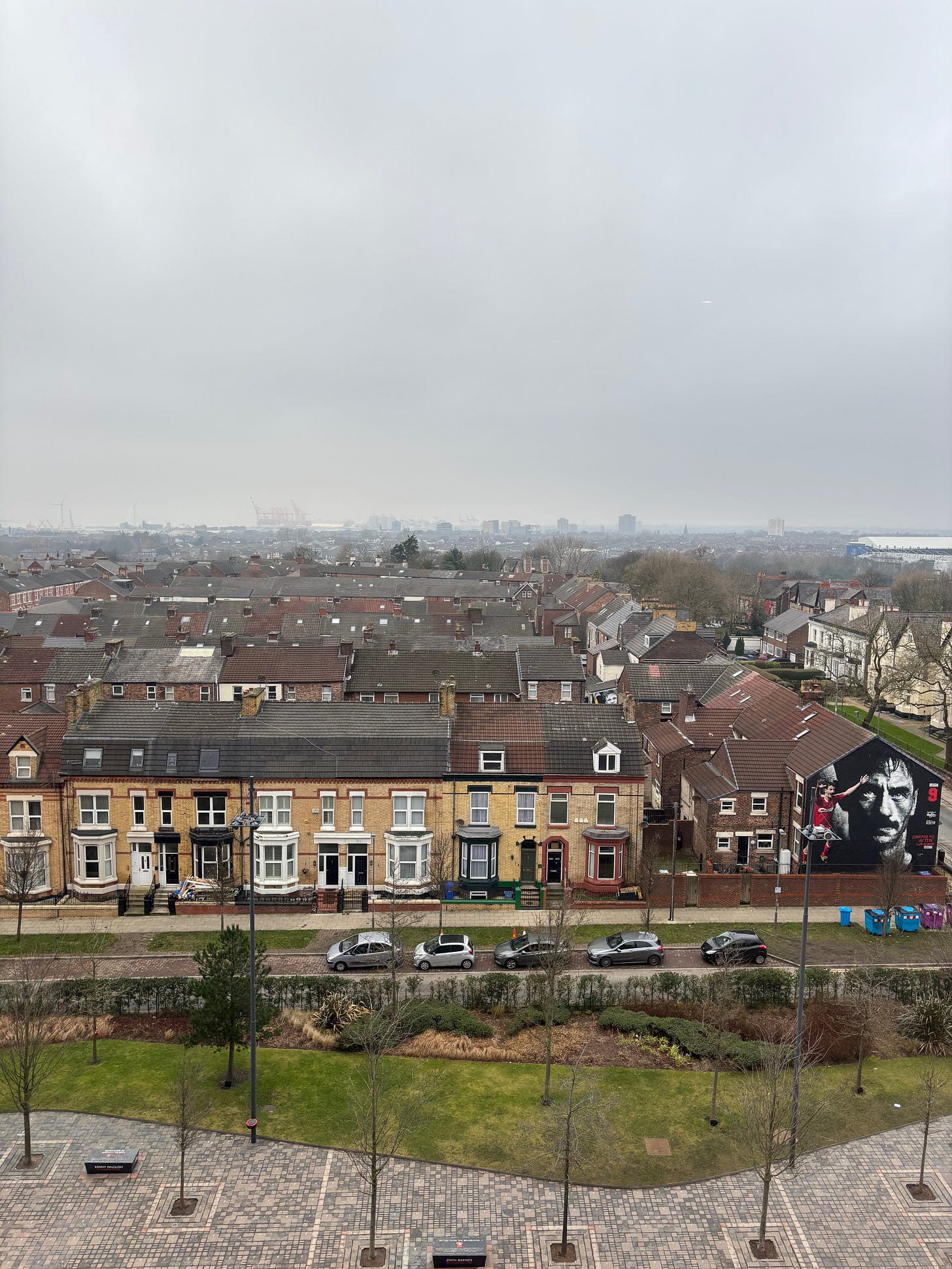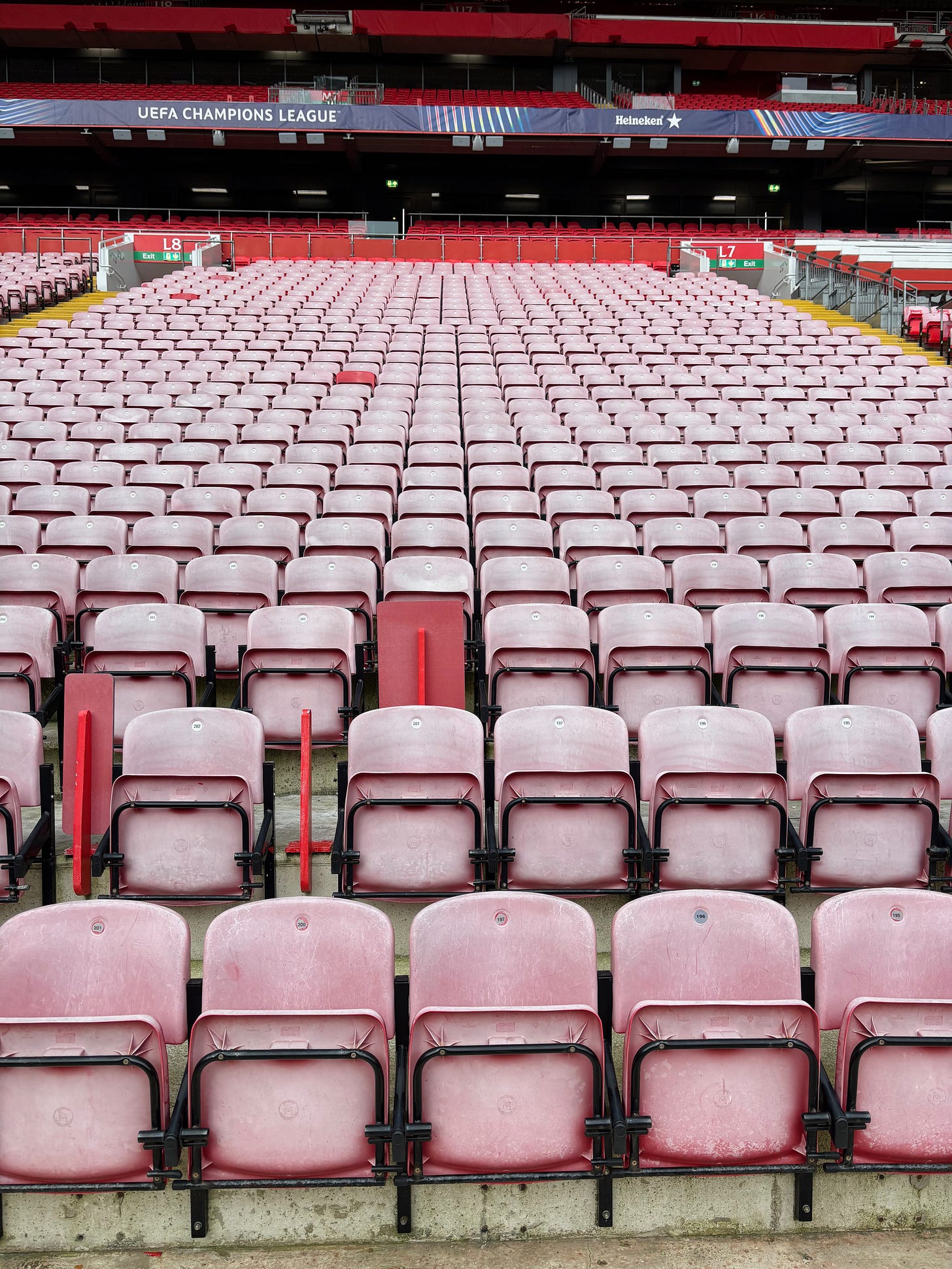Across The Park
Goodison Park's final Merseyside derby had a chaotic ending. Now, Anfield hosts a rematch.
Jack Holmes of THE FOOTBALL WEEKEND attended both Goodison Park and Anfield earlier in 2025. Ahead of the Merseyside derby this week, MTAG has combined excerpts from Jack’s brilliant CATHEDRALS series, covering the world’s great stadiums.
Click the links further down the piece to read those features in full, or check out THE FOOTBALL WEEKEND by hitting the button below.
GOODISON PARK is in a church’s backyard. Back in the day, fans would climb up on the roof of the worship house to earn a free ticket to watch the Blues play. It’s called St. Luke’s Church, and on matchdays, upstairs before kickoff, you’ll find a collective shrine to Everton Football Club. There’s a cast of characters who operate different stalls featuring classic kits, old match programs, historic memorabilia, and—in their proprietors—a whole lot of knowledge.
Richard Gillham, who goes by Richie, operates a stall in the back right corner. He is secretary of the EFC Heritage Society. He stands behind a table arrayed with books with names like Goodison Glory. Above him to the left, there are baseball jerseys from the New York Giants and Chicago White Sox, who once played America’s pastime at Everton’s ground back in 1924. Everton players got involved in a baseball league during the Second World War, he mentioned, and Goodison also played host to an American football game featuring sailors who were stationed in Liverpool. Among them on the USS Leviathan was Humphrey Bogart, though it’s not confirmed he took part in the game. What is for sure is the final score.
“Only Everton could have a nil-nil American football game,” Richie said.
When he was a kid, he used to go to the enclosure at the front of the Main Stand with his dad, and a friend of his dad’s would bring along “the bottom three rungs of an aluminum ladder” for him to stand on so he could see. The enclosure was terracing then, all-standing, and young Richie needed a leg up over the adults.
So did Roger Bennett, the Evertonian romantic at the heart of the Men in Blazers. Over the phone after my visit to Liverpool, I asked him if he remembered his first match at Goodison. “Yeah,” he said. “April 1, 1978. Everton 2, Derby County 1.”
His dad waited until he was six and brought him to a morning kickoff for “a safer, more prudent introduction,” Bennett said. “It was a freezing day, and it was a slightly more violent era. I was just a kid, I didn't really realize what was going on, but I would say it was quite an energetic walk from the car to the stadium.”
There wasn’t much live football on back then, and Match of the Day was on late, so Rog grew up listening to Everton games on the radio. He’d scarcely seen the Goodison pitch outside of newspaper photographs.
“I just remember it being so green, and so startlingly beautiful,” he said. “And the amazing thing is now, when you look at football pitches in the 1970s and 80s, they weren't that green. They were mud piles. But, like, genuinely, it was like the greenest dale I had ever seen. It was stunning and it was beautiful and it was freezing and I couldn't see.
“Everyone stood up around me, grown men, so I couldn't see anything. And the memory I have is that the stranger to my left saw that I couldn't see a thing, and he just lifted me up with one hand, took off a giant jacket that he had on with the other, turned it into a bundle and just plopped me back down on top of his coat. And he goes, ‘Oh, we’re one big family here at Goodison.’ And he stood there in the freezing cold in his T-shirt for the whole game.”
A day out at Goodison was a rougher one in those years. Going to the football was a harsh — occasionally terrifying — experience. But there was warmth in it, too, and Everton were good. Richie was there for the famous Cup Winners’ Cup victory over Bayern Munich in 1985, “one of the greatest nights ever for atmosphere” at Goodison. Back in the day, the attendance could top 60,000—the record was 78,299 for a Merseyside derby in 1948—but then there was Hillsborough, and the Taylor Report in 1990 mandating that English grounds become all-seater.
“I prefer standing, because I think it creates more atmosphere,” Richie said. When I met up with him downstairs at St. Luke’s, Rob Sawyer said the same when I mentioned my seat was in the Gwladys. “In all stadia, it's lost a little something. But you'll enjoy it. You'll feel the history in the wooden beams, the concrete. You’ll love it in there.”
THE FLAT IRON PUB is at the corner of a triangle where two streets meet, not unlike its namesake building in New York. The black asphalt of Walton Breck Road outside was slick with a day’s rain beneath the stone façade painted two shades of green. On the other side of the building, creating the fork in the road where The Flatty sits, is Anfield Road.
Inside the pub, there’s a bar with standing room on both sides, and towards the narrow end there are tables against the walls in a ring. Red pillars rise up to the ceiling, and near the top, arrow-shaped signs bear the names of Irish cities: Kerry, Cavan, Dublin. A chandelier of Stella-style pint glasses hangs near a scarf honoring current left back Andy Robertson. There’s a giant Irish flag with “The Flat Iron Pub - Anfield, Liverpool” superimposed, and still more scarves name-checking clubs like Atlético Madrid and Lech Poznań. There are two empty bottles of Jack Daniels hanging, too, with bulbs inside to give them second life as light fixtures.
It was warm, pints were secured, and a young couple vacated a table along that ringed perimeter just in time for me to take a seat next to Howard Williams. After a few minutes, we got to talking — about the state of the Liverpool team, about my own side, Arsenal, about the battles the two have had down the years and how football has changed and why he still keeps coming.
It’s 56 years since Williams’ first trip to Anfield with his schoolmate — sat across the table from him here — whose father brought them to the match. (When the patriarch died, his grandson, who arrived not long after we sat down, inherited his season ticket.) From then on, Williams would journey up to Anfield Road from his home in Liverpool’s south suburbs, where he said his parents went to pick his older brother up from camp one summer afternoon and returned with an extra boy in the back seat who introduced himself as Paul McCartney (a professed Blue, we should add).
A few pints later, it was time to say our goodbyes. From the warm wood and red and chatter of the Flatty, we all washed out into the black night of northern English winter, joining the stream of red-and-white-scarved characters moving inexorably in one direction down Walton Breck Road. We marched past the rowhouses, the Chinese eatery, the “Hat, scarf, or badge” shop, the perpendicular streets on both sides lined with still more red- or beige-brick rowhouses fronted by painted bay windows.
This is the Liverpool and the Anfield that Gérard Houllier said he fell in love with during a brief time studying here, decades before he became the Liverpool manager. The stadium built into a community, stitched into the fabric of a town. In the years before some of the immediate area was cleared to expand the ground to its current 61,000-plus capacity, it was built in even tighter.
Many heroes in Red lived in the shadow of the stadium. One of the great early captains of Liverpool, Alex Raisbeck, was a commanding Scottish center back who led the team to two league titles in 1901 and 1906 while living in a house on Elsie Road. We passed it on our journey from the Flatty. Then there was a brief stop just outside the stadium perimeter, where the food vendors deal out of painted shipping containers, for a chicken sandwich. Then it was through the turnstiles and into the narrow brick hallways of Anfield.
Many makeovers ago, this place was the property of John Houlding, a local brewer, who leased it to Everton F.C. beginning in 1884. There was no Liverpool Football Club then, and for close to eight years, the Blues played at Anfield.
Except there were devout Methodists on Everton’s board of directors, and they didn’t particularly like the association with a purveyor of alcohol — or having to deal with Houlding, who was by most accounts a difficult man. He raised the rent in 1892, Everton responded by moving across Stanley Park to Goodison, and suddenly Houlding had an 18,000-capacity stadium and nobody to play there. He considered selling it off for housing, but instead he established “Everton F.C. and Athletic Grounds Ltd” — a new club. The Football Association refused to recognize his new creation, however, and he was forced to go for “Liverpool F.C.” Thus was born the rare club that has a stadium before players or fans.
They played their first match at Anfield in September of 1892. By 1906, the legendary stadium architect Archibald Leitch — who is synonymous with many famous stadia in Britain, including Goodison Park, was tapped to build a spectator stand, and the Scotsman had an outsize role in crafting the Anfield architecture for much of its existence. It’s a different place now, the product of multiple redesigns and a dramatic expansion of the Main and Anfield Road stands, but in those narrow hallways, fighting to get a pint at halftime, you can feel the place has been there forever.
*Photo credit: Jack Holmes









